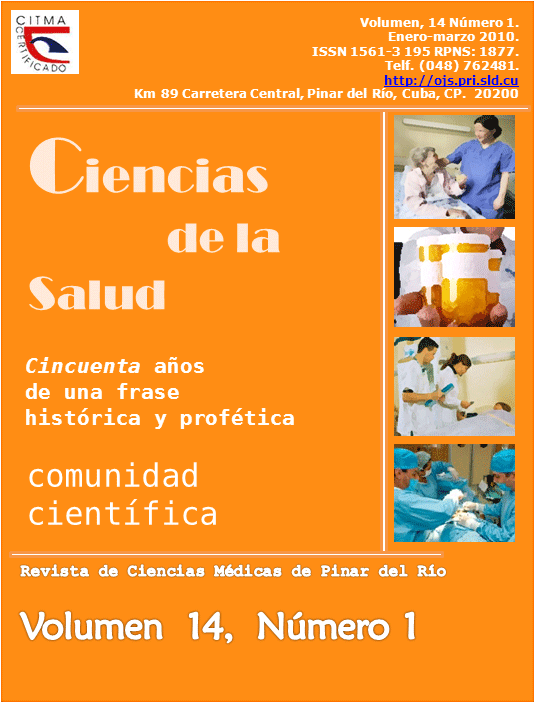Abdominal Sonography: its use in a comprehensive imaging study in pediatric patients suffering from Portal Hypertension
Abstract
Pediatric Portal Hypertension (PPH) is a health problem in Cuba; that is why an applied, descriptive, explanatory, longitudinal and prospective research was carried out at "Pepe Portilla" Children Teaching Hospital during 2006-2007. Objective: To demonstrate the usefulness of the abdominal Sonography in the diagnosis, natural history and prognosis of these patients. The universe and sample was comprised of both-sexes, and all ethnic patients having a confirmed diagnosis of PPH. Age, sex, pathological records, most frequent symptoms, signs, findings through conventional abdominal ultrasound, Doppler Sonography and sonographic evolution were the variables analyzed. Results showed: male sex prevailed, homogeneous distribution among the group of ages, more than the half of patients presented history of umbilical catheterization during neonatal period, among the symptoms: abdominal pain, upper digestive bleeding and spleen enlargement stood out; the most frequent findings were: splanchnomegaly, alterations of the liver echostructure, collateral circulation and alterations of the portal system, which was notable with Doppler ultrasound; the group of patients presenting stable conditions prevailed regarding sonographic progress.Downloads
References
1. Hidalgo Marrero Y. Metodología para la atención integral a la Hipertensión Portal Prehepática Pediátrica en Cuba. (Tesis).Holguín: Portal de la Asociación Iberoamericana de cirujanos pediátricos; 2006.
2. Trinchet Soler R, Hidalgo Marrero Y, Marcano Sanz L, Villamil Martínez R. Diagnostico y tratamiento de la Hipertensión portal en el niño. Guía aprobada por consenso en el Primer Taller Nacional de Buenas Prácticas Clínicas en Cirugía Pediátrica. Cienfuegos: 7-9 de Marzo; 2002.
3. Ugarte Suárez JC, Banasco Domínguez J, Ugarte Moreno D. Identificación de imágenes anormales del sistema digestivo y del abdomen. Manual de Imagenología. 2a ed. Cuba: Editorial Ciencias Médicas; 2004.p.107-132.
4. López Masó I, Zaldívar Cordón Z, Labrada Maldonado A, Arenado Durán A, González Álvarez G. Comportamiento evolutivo de los pacientes diagnosticados con hipertensión portal en Holguín.1992-2002. Correo Científico Médico de Holguín[revista en internet] 2006[citado Sept 2009];10(3). Disponible en: http://www.cocmed.sld.cu/no103/n103ori7.htm
5. Lievit C, Kiernan M. The hepatic circulation and portal hypertension. Sem Ped Surgery. 2002; 10 (2):92-4.
6. Chirinos Vega J.A, Muñoz Gómez R, Amo Peláez M, Ibarrola de Andrés C, Solís Herruzo J.A. Trombosis portal y mesentérica asociada al déficit de la proteína S. Rev. esp. enferm. dig. Madrid feb. 2008; 100(2): 104-107.
7. Velásquez Chamochumbi. Hemorragia digestiva por várices esófago-gástricas. Acta Méd. Peruana. 2007; 23(3): 33-7
8. Velásquez Ch, Espejo H. Reporte de 8320 casos de hemorragia digestiva en el Hospital Rebagliati. Lima, Perú. XX Congr Per Enf Diges; 2006.
9. Pedrosa CS. El abdomen: El Hígado. En Diagnóstico por Imagen. Tratado de Radiología Clínica. 2a. ed. V-1. Madrid. McGraw Hill Interamericana. ECMED; 2004.p. 519-50.
10. Fernández Pérez F. J., Jiménez Sáenz M., García Montes J. M., Rebollo Bernárdez J., Herrerías Gutiérrez J. M. Efecto hemodinámico esplácnico de somatostatina y octreótido en cirróticos: Estudio con ultrasonografía Doppler. Rev. esp. enferm. dig. [revista en la Internet]. 2008 Sep [citado 2009 Ene 12];100(9): 552-559. Disponible en: http://scielo.isciii.es/scielo.php?script=sci_arttext&pid=S1130-01082008000900005&lng=es
11. Fernández Pérez FJ, García Montes JM, Castro Laria L, Martin Guerrero JM, Jiménez Saenz M, Herrerias Gutiérrez JM et al. Usefullness of ultrasonography in the diagnosis of portal hypertensión. Rev Esp Enferm Dig[Revista en Internet]. 1998 Nov; [Acceso el 13 de febrero 2008] 90(11):806-12. Disponible en: http://www.ncbi.nlm.nih.gov/pubmed/9866413
12. Harris D. Paul, Brinck M. Patricio. Un análisis retrospectivo de cavernomatosis de la vena porta en Chile.: I. Perfil clínico y de laboratorio. Rev. chil. pediatr [revista en la Internet]. 1999 Mayo [citado 18 de enero 2008]; 70(3): 188-193. Disponible en: http://www.scielo.cl/scielo.php?script=sci_arttext&pid=S0370-41061999000300003&lng=es
13. Sánchez CC, J Rodríguez C F, Domar Hipertensión Portal en Pacientes pediátricos con antecedentes de Onfaloclisis Ciudad Hospitalaria Dr. Enrique Tejera 1994.1999. Salus [revista en internet]abr. 2003 [citado18 de enero 2008] ;7(1):34-38. Disponible en: http://bases.bireme.br/cgi-bin/wxislind.exe/iah/online/?IsisScript=iah/iah.xis&src=google&base=LILACS&lang=p&nextAction=lnk&exprSearch=502686&indexSearch=ID
14. de León Berland N. Valor del ultrasonido Doppler Dúplex y Doppler color en el estudio del sistema venoso portal de pacientes con hepatopatía crónica. Correlación con la biopsia hepática. Resultados. Indexmedico journal.[revista en internet] Agosto 2009 [citado Ene 2008],3: Disponible en: http://www.indexmedico.com/publicaciones/indexmed_journal/edicion3/doppler_porta_hepatopatia/berland_de_leon.htm
15. García-Pagan JC, Hernández-Guerra M. Trombosis Portal. Panel de Expertos Octubre 2004. Disponible en: http://www.hepatonet.com/formación/expertos19.php
16-Suárez Quintero Y. Hipertensión portal: su medida en la práctica clínica. Rev Col Gastroenterol. Bogotá 2007; 22 (1) Print version ISSN 0120-9957
17.ShinoharaT, Ando H, Watanabe Y, Seo T, Harada T, Kaneko K et al. Extrahepatic portal vein morphology in children with extrahepatic portal hypertension assessed by 3-dimensional computed tomographyc portography: a new etiology of extrahepatic portal hypertension. J Pediatr. 2006; 41(4):812-6.
18. E Arteche, Ostiz S, Miranda I,Caballero P, Jiménez López de Oñate G. Tromboflebitis séptica de la vena porta (pileflebitis): diagnóstico y manejo a propósito de tres casos. Anales Sis San Navarra. 2005; 28(3) :417-20.
Published
How to Cite
Issue
Section
License
Authors who have publications with this journal agree to the following terms: Authors will retain their copyrights and grant the journal the right of first publication of their work, which will be publication of their work, which will be simultaneously subject to the Creative Commons Attribution License (CC-BY-NC 4.0) that allows third parties to share the work as long as its author and first publication in this journal are indicated.
Authors may adopt other non-exclusive license agreements for distribution of the published version of the work (e.g.: deposit it in an institutional telematic archive or publish it in a volume). Likewise, and according to the recommendations of the Medical Sciences Editorial (ECIMED), authors must declare in each article their contribution according to the CRediT taxonomy (contributor roles). This taxonomy includes 14 roles, which can be used to represent the tasks typically performed by contributors in scientific academic production. It should be consulted in monograph) whenever initial publication in this journal is indicated. Authors are allowed and encouraged to disseminate their work through the Internet (e.g., in institutional telematic archives or on their web page) before and during the submission process, which may produce interesting exchanges and increase citations of the published work. (See The effect of open access). https://casrai.org/credit/



